1984 NISSAN 300ZX charging
[x] Cancel search: chargingPage 1 of 38
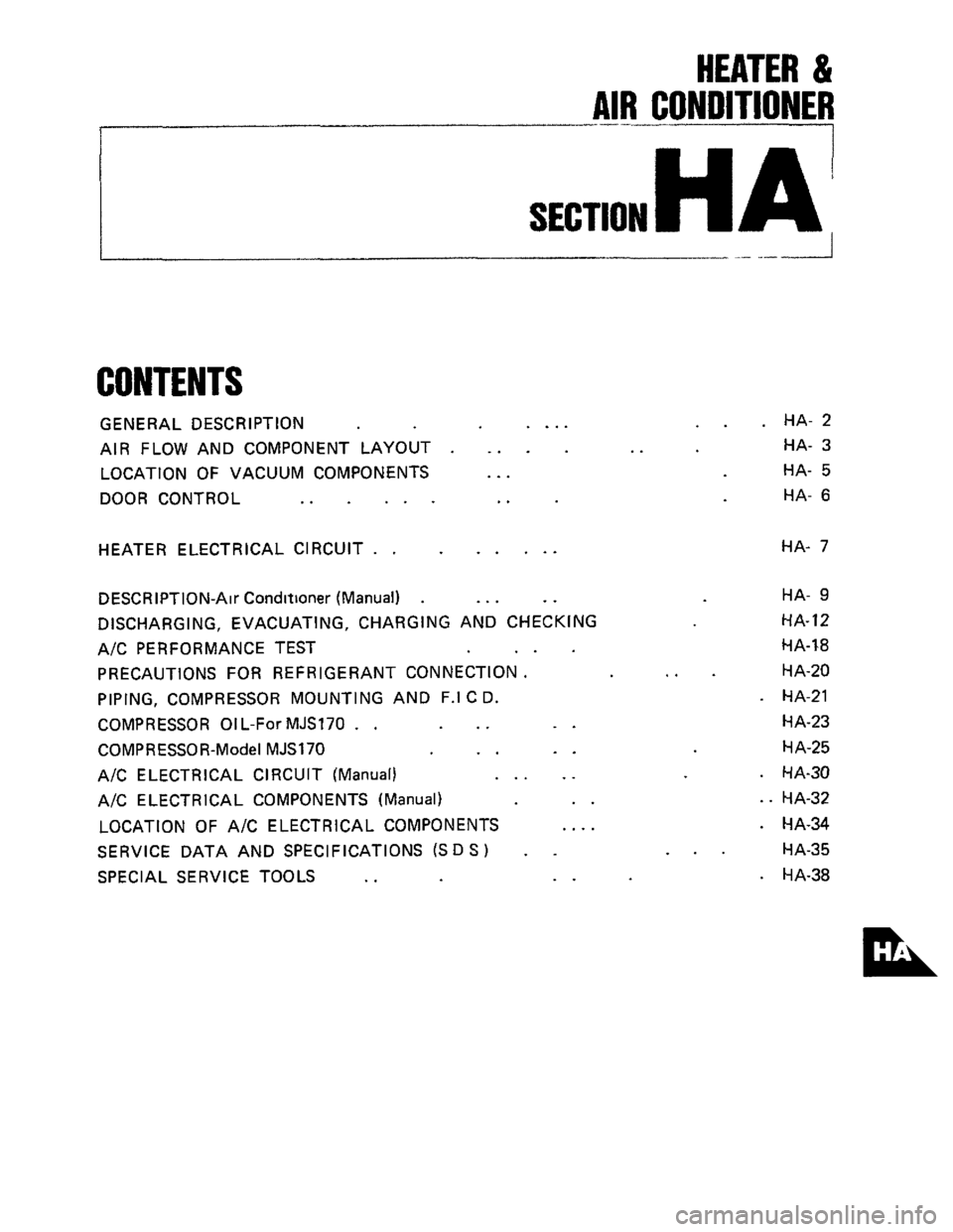
HEATER &
AIR CONDITIONER
I v __I_--
SECTION HA^ I
CONTENTS
GENERAL DESCR I PTlON . ... .. . HA- 2
AIR FLOW AND COMPONENT LAYOUT
. .. . .. HA- 3
DOOR CONTROL .. 1.. .. HA- 6
LOCATION OF VACUUM COMPONENTS ... HA- 5
HEATER ELECTRICAL CIRCUIT. . . . . .. HA- 7
DESCRIPTION-Air Conditioner (Manual) . ... ..
A/C PERFORMANCE TEST ..
DISCHARGING, EVACUATING, CHARGING AND CHECKING
PRECAUTIONS FOR REFRIGERANT CONNECTION .
PIPING, COMPRESSOR MOUNTING AND F.1 C D.
COMPRESSOR OIL-ForMJS170
. . .. ..
COMPRESSOR-Model MJS170 .. ..
A/C ELECTRICAL CIRCUIT (Manual) . .. ..
A/C ELECTRICAL COMPONENTS (Manual) ..
LOCATION OF A/C ELECTRICAL COMPONENTS ....
SERVICE DATA AND SPECIFICATIONS (S D S ) . .
SPECIAL SERVICE TOOLS .. ..
HA- 9
HA-12
HA-18
HA-20
. HA-21
HA-23
HA-25
. HA-30
.. HA-32
. HA-34
.. HA-35
. HA-38
Page 12 of 38
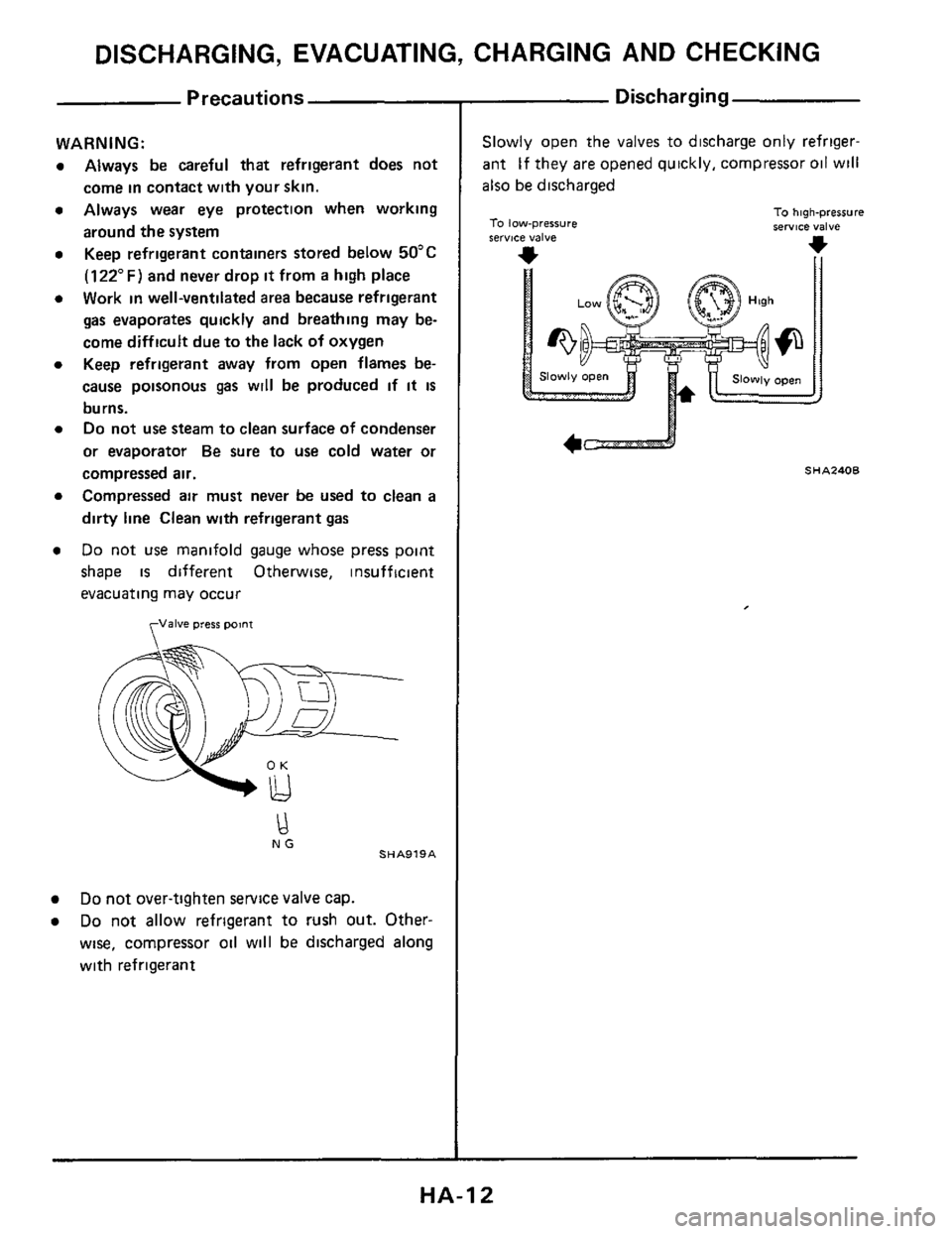
DISCHARGING, EVACUATING, CHARGING AND CHECKING
Precautions
WARNING:
Always be careful that refrigerant does not
come in contact with your skin.
Always wear
eye protection when working
around the
system
Keep refrigerant containers stored below 50°C
(122" F) and never drop it from a high place
Work
in well-ventilated area because refrigerant
gas evaporates quickly and breathing may be-
come difficult due to the lack of oxygen
Keep refrigerant away from open flames
be-
cause poisonous gas will be produced if it is
burns.
Do not use steam to clean surface of condenser
or evaporator
Be sure to use cold water or
compressed air.
Compressed
air must never be used to clean a
dirty line Clean with refrigerant gas
Do not use manifold gauge whose press point
shape
is different Otherwise, insufficient
evacuating may occur
fJalve press point
NG SHA919A
Do not over-tighten service valve cap.
Do not allow refrigerant to rush out. Other-
wise, compressor oil will
be discharged along
with refrigerant
Discharging
Slowly open the valves to discharge only refriger-
ant If they
are opened quickly, compressor oil will
also be discharged
To low-pressure IerYlCe valve
To high-pressure service valve
*
SHA240B
4c==--J
HA-I 2
Page 13 of 38
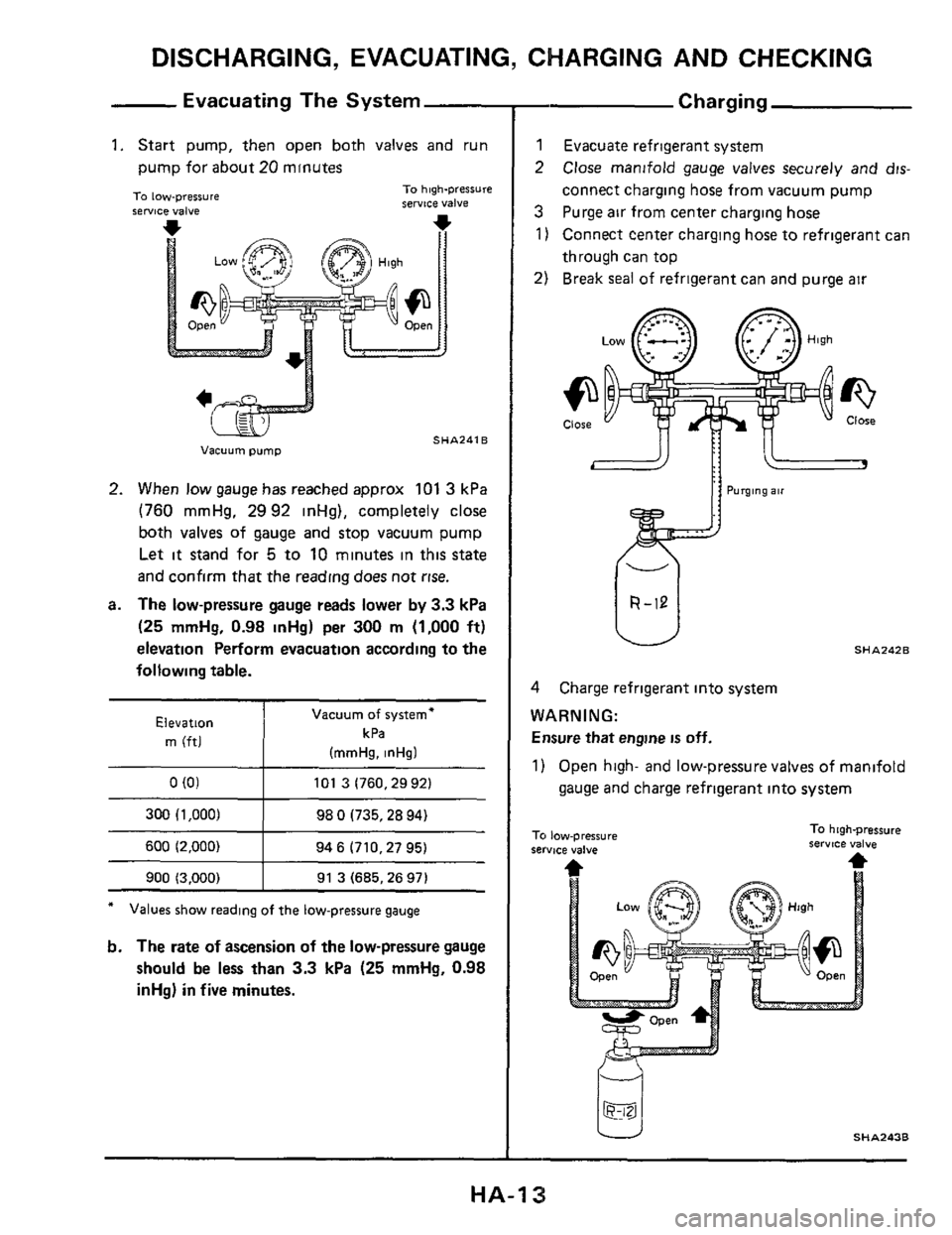
DISCHARGING, EVACUATING, CHARGING AND CHECKING
0 (0)
300 /1,000)
Evacuating The System
1. Start pump, then open both valves and run
pump for about 20 minutes
-. -
101 3 (760.29 92)
98
0 (735.28 94)
To high-pressure serwce valve To low-pressure
600 (2,000)
Vacuum pump
94 6 (710.27 95)
SHA241 B
900 (3.000)
2. When low gauge has reached approx 101 3 kPa
(760 mmHg, 2992 inHg), completely close
both valves of gauge and stop vacuum pump
Let
it stand for 5 to 10 minutes in this state
and confirm that the reading does not rise.
a. The low-pressure gauge reads lower by 3.3 kPa
(25 mrnHg, 0.98 inHg) per 300 rn (1.000 ft)
elevation Perform evacuation according to the
following table.
91 3 (685.26 97)
I
Vacuum of system*
kPa
(mmHs. inHal
Elevation
m (ftl
* Values show reading of the low-pressure gauge
b. The rate of ascension of the low-pressure gauge
should be less than
3.3 kPa (25 mmHg, 0.98
inHg) in five minutes.
- Charging
1 Evacuate refrigerant system
2
Close manifold gauge valves securely and dis-
connect charging hose from vacuum pump
3 Purge air from center charging hose
1) Connect center charging hose to refrigerant can
through can top
2) Break
seal of refrigerant can and purge air
SHA2428
4 Charge refrigerant into system
WARNING:
Ensure that engine is off.
1) Open high- and low-pressure valves of manifold
gauge and charge refrigerant into system
SHA243B
HA-I 3
Page 14 of 38
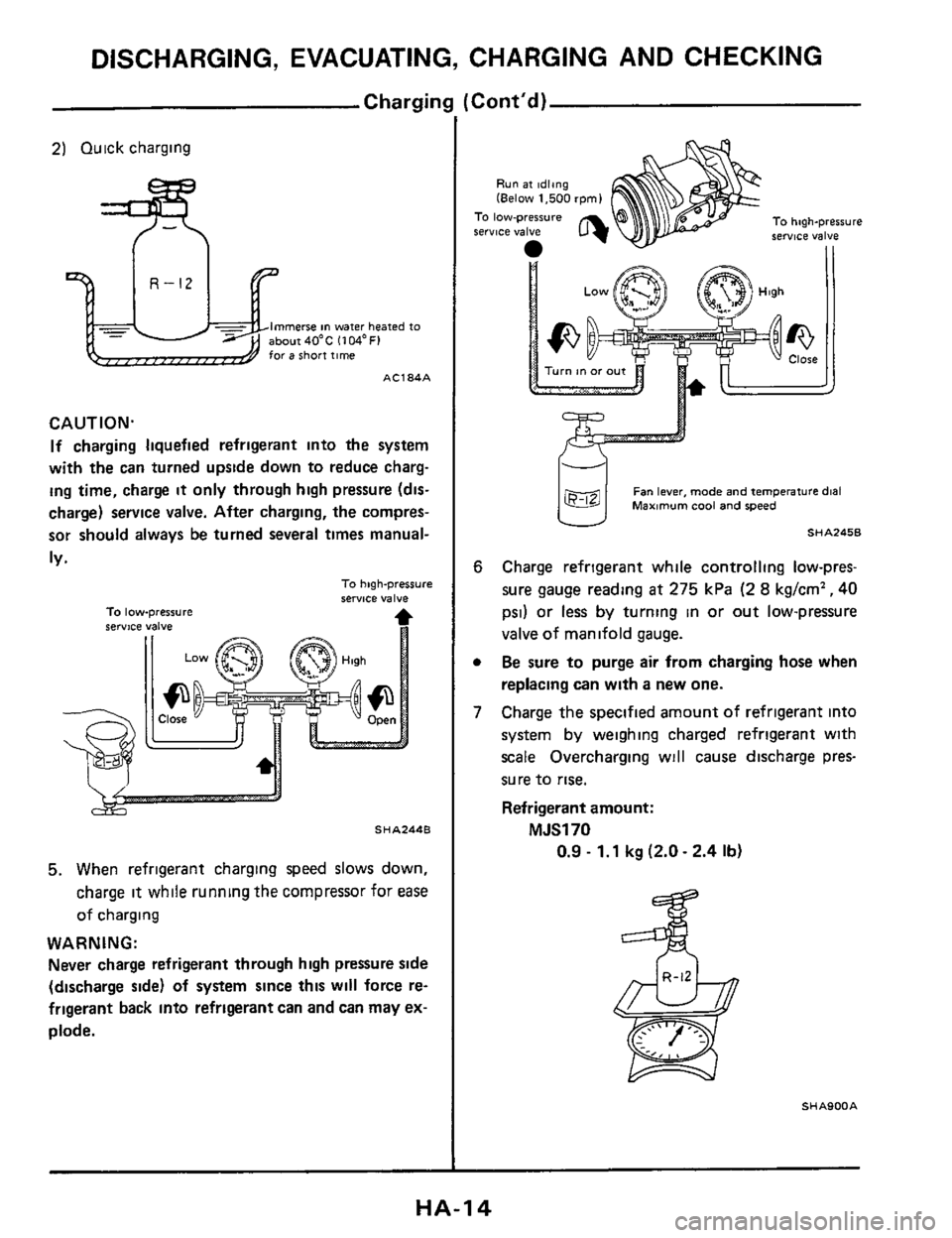
DISCHARGING, EVACUATING, CHARGING AND CHECKING
Chargin!
2) Quick charging
Immerse in water heated to about40*C 11W0FI for a Short time
AC184A
CAUTION.
If charging liquefied refrigerant into the system
with the can turned upside down to reduce charg-
ing time, charge it only through high pressure (dis-
charge) service valve. After charging, the compres-
sor should always be turned several times manual-
ly.
To high-pressure sermce valve To low-pressure
SHA244B
5. When refrigerant charging speed slows down,
charge
it while running the compressor for ease
of charging
WARNING:
Never charge refrigerant through high pressure side
(discharge
side) of system since this w~ll force re-
frigerant back into refrigerant can and can may
ex-
plode.
Cont'd)
Run at Idling (Below 1.500 rpml
To high-pressure servlce valve
II
To low-pressure IerUlCe valve
@g Fan lever, made and temperature dial Maximum cool and speed
I? SHAZ~SB
Charge refrigerant while controlling low-pres
sure gauge reading
at 275 kPa (2 8 kg/cm2, 40
psi) or less by turning in or out low-pressure
valve of manifold gauge.
Be sure to purge air from charging hose when
replacing can with a new one.
Charge the specified amount of refrigerant into
system by weighing charged refrigerant with
scale Overcharging will cause discharge pres-
sure
to rise.
Refrigerant amount:
MJS170
0.9 - 1.1 kg (2.0 - 2.4 Ib)
SHA9OOA
HA-I 4
Page 15 of 38
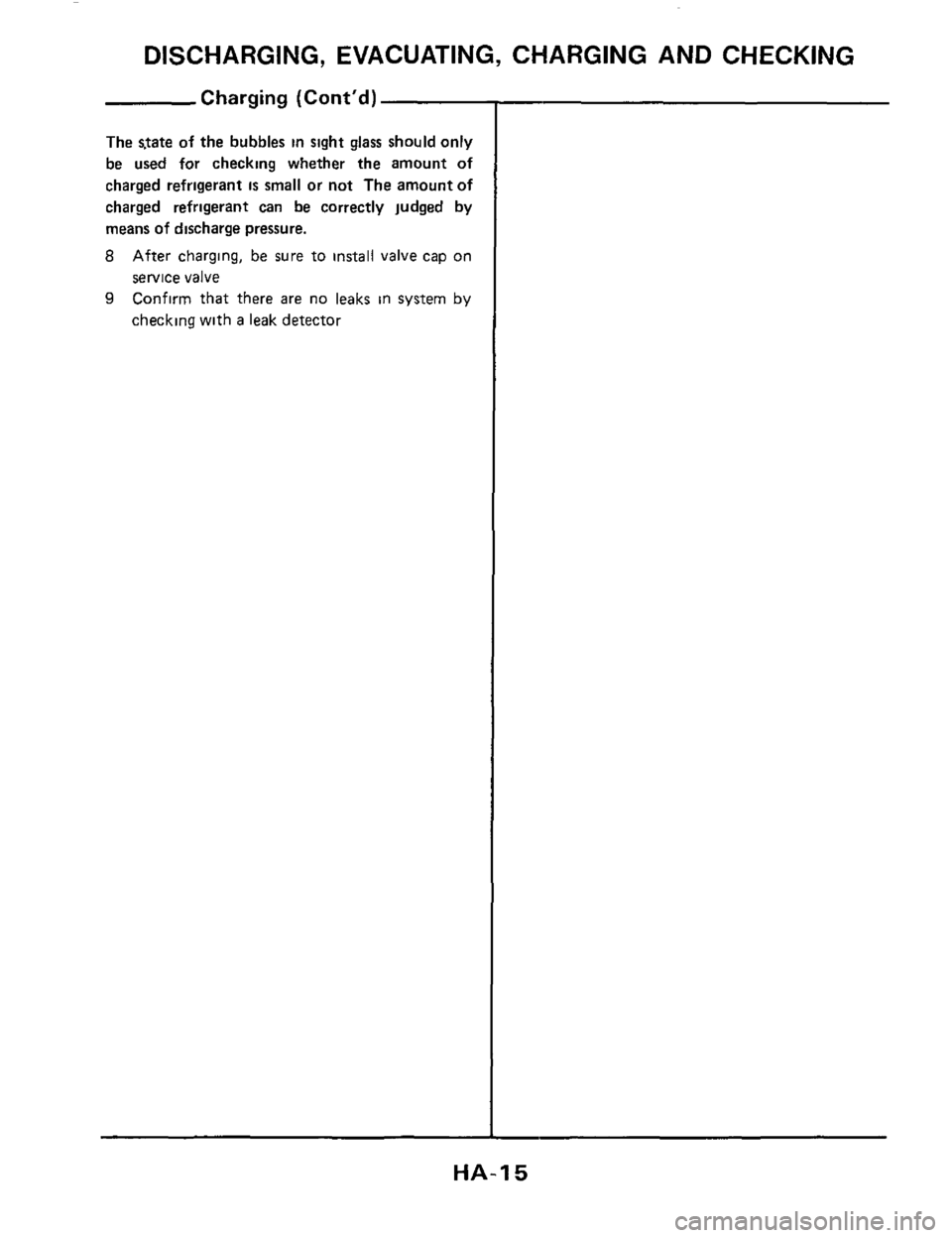
DISCHARGING, EVACUATING, CHARGING AND CHECKING
Charging (Cont'd)
The state of the bubbles in sight glass should only
be used for checking whether the amount of
charged refrigerant is small or not The amount of
charged refrigerant can be correctly judged by
means of discharge pressure.
8 After charging, be sure to install valve cap on
service valve
9 Confirm that there are no leaks in system by
checking with a leak detector
HA-I 5
Page 16 of 38
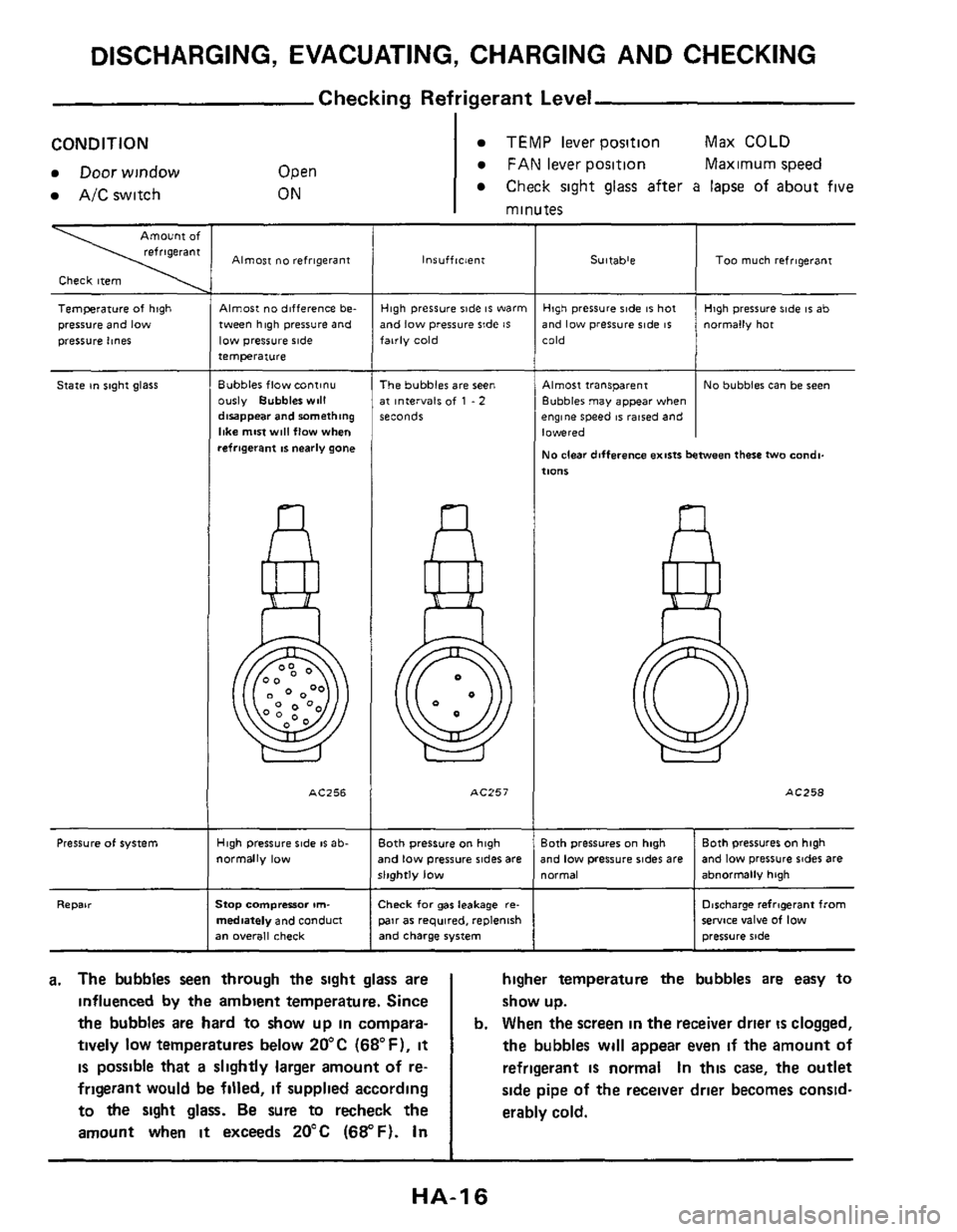
DISCHARGING, EVACUATING, CHARGING AND CHECKING
Checking Refrigerant Level
I
Suitable
CONDITION
Door window
AIC switch
TOO much refrigerant
Open
ON
TEMP lever position Max COLD
FAN lever position Maximum speed
Check sight glass after a lapse of about five
minutes
Check item
Terneralure of high
pressure and
low
pressure lines
Staie !n slght glass
Pressure of system
Repair
Almost no refrigerant
Almost no difference be-
tween high pressure and
low pressure side temperature
Bubbles flow continu
ously Bubbler will disappear and something
like mest will flow when
refrigerant
IS nearly gone
AC256
High Pressure side os ab-
normally low
Stop compressor m.
mediately and conduct an Overall check
iigh pressure side IS warm
Ind low pressure side is
awly cold
-he bubbler are seen
it inieivals of 1 - 2
econds
ACZ57
loth pressure on high
nd low pressure sides are
lighfly low
:heck for gas leakage re-
air as required. replenish Nnd charge system
a. The bubbles seen through the sight glass are
influenced by the ambient temperature. Since
the
bubbles are hard to show up in compara-
tively
low temperatures below 20°C (68°F). it
is possible that a slightly larger amount of re-
frigerant would be filled,
if supplied according
to the sight glass.
Be sure to recheck the
amount when
it exceeds 20°C (68°F). In
iigh pressure ride is hot
ind
low pressure ride 8s
High pressure Side IS ab
normally hot
4Imost transparent
lubblei may appear when ,ngine speed 8s raised and
owered
do dear difference exists between these two condi-
No bubbler can be seen
10"s
AC258
:oth pressures on high
nd
low pressure rides are ormal abnormally hgh
Both pressures on high
and
low pressure rider are
Dmharge refragerant from sewice valve of low
pressure ride
higher temperature the bubbles are easy to
show up.
b. When the screen in the receiver drier is clogged,
the bubbles will appear
even if the amount of
refrigerant
IS normal In this case, the outlet
side pipe of the receiver drier becomes consid-
erably cold.
1
HA-I 6
Page 17 of 38
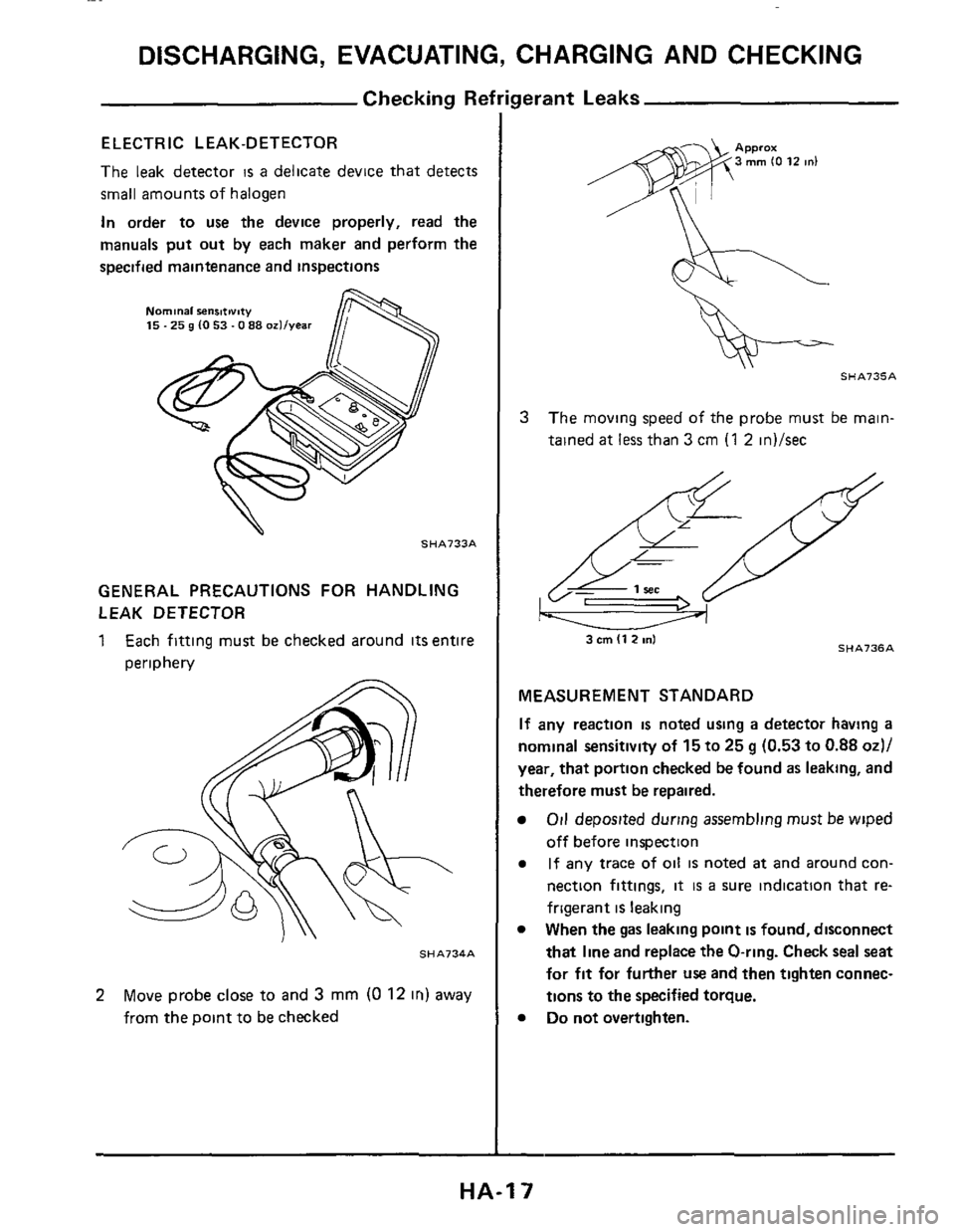
DISCHARGING, EVACUATING, CHARGING AND CHECKING
ELECTRIC L EAK-DETECTOR
The leak detector IS a delicate device that detects
small amounts of halogen
In order to
use the device properly, read the
manuals
put out by each maker and perform the
specified maintenance and inspections
Nominal senmivity 15.25 g (0 53.0 88 ozllvear
.. SHA733A
GENERAL PRECAUTIONS FOR HANDLING
LEAK DETECTOR
1 Each fitting must be checked around its entire
periphery
SHA734A
2 Move probe close to and 3 mm (0 12 in) away
from the point to be checked
SHA735A
3 The moving speed of the probe must be main-
tained
at less than 3 cm (1 2 in)/sec
SHA736A 3 cm (1 2 ml
MEASUREMENT STANDARD
If any reaction is noted using a detector having a
nominal sensitivity of 15 to 25 g (0.53 to 0.88 od/
year, that portion checked be found as leaking, and
therefore must be repaired.
Oil deposited during assembling musr be wiped
off before inspection
If any trace of oil is noted at and around con-
nection fittings,
it is a sure indication that re-
frigerant
is leaking
When the
gas leaking point is found, disconnect
that line and replace
the O-ring. Check seal seat
for fit for further use and then tighten connec-
tions
to the specified torque.
Do not overtighten.
HA-I 7